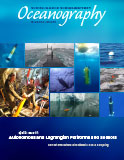Article Abstract
Polar oceans are poorly monitored despite the important role they play in regulating Earth’s climate system. Marine mammals equipped with biologging devices are now being used to fill the data gaps in these logistically difficult to sample regions. Since 2002, instrumented animals have been generating exceptionally large data sets of oceanographic CTD casts (>500,000 profiles), which are now freely available to the scientific community through the MEOP data portal (http://meop.net). MEOP (Marine Mammals Exploring the Oceans Pole to Pole) is a consortium of international researchers dedicated to sharing animal-derived data and knowledge about the polar oceans. Collectively, MEOP demonstrates the power and cost-effectiveness of using marine mammals as data-collection platforms that can dramatically improve the ocean observing system for biological and physical oceanographers. Here, we review the MEOP program and database to bring it to the attention of the international community.

